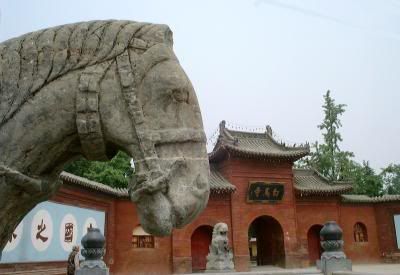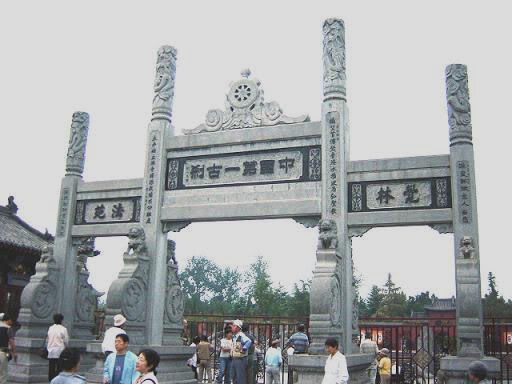Bạch Mã Tự, ngôi chùa Phật Giáo cổ xưa nhất Trung Quốc

Từ Ðời Tần và Tây Hán, đã có tăng sĩ từ Thiên Trúc (cổ Ấn Ðộ ) lui tới Trung Quốc du thuyết và cũng đã có nhiều thiện tín, tuy nhiên thời bấy giờ không có một trú xứ nào cho tăng sĩ lưu ngụ, mãi đến đời Ðông Hán, Hán Minh Ðế năm thứ 11 niên đại Vĩnh Bình mới kiến tạo Bạch Mã Tự ở Lạc Dương, Hà Nam, vì vậy, Bạch Mã Tự là ngôi Phật Tự đầu tiên tại Trung Quốc, đến nay đã hơn 1900 năm, được tôn xưng là “Tổ Ðình”, “Thích Nguyên” của Phật Giáo Trung Quốc. Chính vì vậy Bạch Mã Tự có một địa vị hết sức đặc biệt đối với Phật Giáo Trung Quốc.
Truyền thuyết nói rằng một đêm trong năm 64 sau Tây Lịch, Hán Minh Ðế Lưu Trang (25-220) nằm mộng thấy một “kim nhân -người vàng” cao 12 feet, và hào quang của kim nhân tỏa ra chiếu sáng cả gian phòng. Buổi sáng lâm triều, nhà vua thuật lại cho quần thần và được biết rằng người mà nhà vua nằm mộng thấy chính là Ðức Phật. Hán Minh Ðế sai hai sứ thần Thái Linh và Tần Cảnh cùng sứ đoàn 18 người sang Thiên Trúc để thỉnh kinh. Vào năm 67 sau Tây Lịch, nhóm sứ thần của Hán Minh Ðế trở về Lạc Dương, thỉnh hai Ngài Ca Diếp Ma Ðằng Kasyapamatanga và Trúc Pháp Lan Dharmaranya, hai vị Phạm Tăng từ Ấn Ðộ sang Trung Quốc truyền giáo, chở theo kinh điển Sankrist và cả tượng Phật Thích Ca Mâu Ni bằng ngựa trắng. Minh Ðế nhân đó cho kiến tạo một ngôi tự viện để thờ phụng tượng Phật Thích Ca và cất giữ kinh sách đặt tên là Bạch Mã Tự.
 Hai Ngài Ca Diếp Ma Ðằng và Trúc Pháp Lan ở tại Bạch Mã Tự dịch “ Tứ Thập Nhị Chương Kinh” cũng là bộ kinh được dịch ra Hán Ngữ đầu tiên. Năm Gia Bình nhị niên ( năm 250 sau Tây Lịch), Tỳ Khưu Kha Ðàm Già La du hóa đến đấy, chủ trương mọi hành vi nhất thiết tuân theo lời Phật tổ dạy, tăng chúng Lạc Dương thỉnh Ngài dịch kinh giới luật, nhân đó bộ kinh “ Tăng Chỉ Giới Tâm” được Ngài Kha Ðàm Già La dịch ra là bộ Kinh Giới Luật đầu tiên tại Trung Quốc.
Hai Ngài Ca Diếp Ma Ðằng và Trúc Pháp Lan ở tại Bạch Mã Tự dịch “ Tứ Thập Nhị Chương Kinh” cũng là bộ kinh được dịch ra Hán Ngữ đầu tiên. Năm Gia Bình nhị niên ( năm 250 sau Tây Lịch), Tỳ Khưu Kha Ðàm Già La du hóa đến đấy, chủ trương mọi hành vi nhất thiết tuân theo lời Phật tổ dạy, tăng chúng Lạc Dương thỉnh Ngài dịch kinh giới luật, nhân đó bộ kinh “ Tăng Chỉ Giới Tâm” được Ngài Kha Ðàm Già La dịch ra là bộ Kinh Giới Luật đầu tiên tại Trung Quốc.
Bạch Mã Tự đến nay đã có nhiều thay đổi, nó được xây dựng lại vào thời nhà Minh (1368-1644), với chu vi 40 ngàn mét vuông, cổng tam quan bằng đá xanh có vài mẫu đá còn lại từ thời Ðông Hán.
Ðược phân bố dài theo trục chính hướng Bắc là Thiên Vương Ðiện, Ðại Phật Ðiện, Ðại Hùng Ðiện, Bì Lô Ðiện, Tiếp Dẫn Ðiện,Vân Thủy Ðường , Tổ Ðường , Thiền đường, Thanh lương đài, Tế Vân Tháp 13 tầng cao 25 mét cũng được xem như là ngôi tháp đầu tiên tại Trung Quốc. Trong điện bài trí tượng Phật Thích Ca, Phật A Di Ðà, Phật Di Lặc, Phật Dược Sư và nhiều hình tượng Bồ Tát khác, trên tường trang trí bằng nhiều bức bích họa (tranh vẽ thẳng lên tường).
Bạch mã tự còn có một hiện tượng thần kì, gọi là " Mã tự chung thanh - Tiếng chuông Bạch Mã Tự ", là đệ nhất trong tám cảnh đẹp Lạc Dương. Truyền thuyết rằng mỗi khi đêm trăng thanh gió mát, trong canh khuya tĩnh mịch, tiếng chuông chùa Bạch Mã có thể vang xa tới mười dặm liên tục không dứt .
Hạt Cát lược dịch tổng hợp từ các web site:
http://chinatravelz.com/china/Henan/Luoyang/baimasi/index.asp
http://www.people.com.cn/GB/14838/22117/28532/28536/1943411.html Hoa Văn
http://www.epochtimes.com/gb/3/5/19/n314949.htm Hoa Văn
The White Horse Temple - The First Buddhist Temple in China
The Baima Temple in Luoyang, Henan Province, was the first Buddhist Temple in China. It is said that one night in the year A. D. 64, Emperor Mingdi of the Eastern Han Dynasty (25-220) dreamed of a golden man 12 feet high, and the light from the man's head illuminated the hall where he stood.
In the morning, the emperor told his officials what he had seen, and one of them, named Fu Yi, said the emperor had dreamed of the Buddha, a god of the West. Then the emperor sent Cai Yin, Qin Jing, and others to Tianzhu (now India) for Buddhist scriptures.
When Cai, Qin, and their group arrived in what is now Afghanistan, they met Kasyapamatanga and Dharmaranya, two eminent Indian monks, who were preaching Buddhism there. In A. D. 67, they loaded Buddhist scriptures written in Sanskrit and a portrait on white felt of Sakyamuni, the Buddha, onto a white horse and returned to Luoyang with the two Indian monks. The emperor lodged the monks at the Honglu Temple, which had a guesthouse for foreign emissaries. When living quarters for the monks were built in the temple the following year, the temple was renamed Baima (White Horse) Temple so people could remember the white horse that carried back the Buddhist scriptures and the portrait of Sakyamuni.
The Baima Temple has been through many changes. What we see today is a rectangular courtyard complex facing south, reconstructed during the Ming Dynasty (1368-1644), with an area of 40,000 square meters and a roofed entrance arch with three doorways. The entrance is built of blue stones, including several pieces from the Eastern Han Dynasty.
Arranged along a central axis that extends northward inside the entrance are the Hall of the Heavenly King, the Mahavira Hall, the Receiving and Directing to Paradise Hall, the Vairocana Pavilion, and the majestic Hall of the Giant Buddha, with its upturned eaves and painted brackets.
On the east side of the halls and the pavilion are the Guest Hall, the Hall of Prayer, the Hall of Abstinence, and the living chambers of the monks. On the west are the Hall of the Founder of Buddhism, the Hall of Meditation, and the Preaching Hall. There are two opposite courtyards, and the complex as a whole is well proportioned. It has the flavor of traditional Chinese architecture and shows a distinction between more important and less important structures.
All the halls housing statues of Sakyamuni, Maitreya, Amitabha, the Buddha of Medicine, and various bodhisattvas are built on the central axis following the terrain, and each hall stands higher than the one in front. The Vairocana Pavilion on Qingliang Terrace stands especially prominent and magnificent.
The Qiyun Pagoda was built after the temple was renamed Baima Temple and is known as the first pagoda in China. Originally, it was a pavilion-like wooden structure with paintings depicting Buddhist scriptures. It burned down toward the end of the Northern Song Dynasty (960-1127) and was rebuilt in 1175 as a 13-story square brick structure with closely arranged eaves. It is 25 meters in height and 7.8 meters on each side at the bottom. The eaves are built with small, exquisite overlapping bricks.
When one claps one's hands 20 meters away from the pagoda, the echo reflected from the eaves sounds like frogs croaking.
http://chinatravelz.com/china/Henan/Luoyang/baimasi/index.asp
0 Comments:
Đăng nhận xét
<< Home